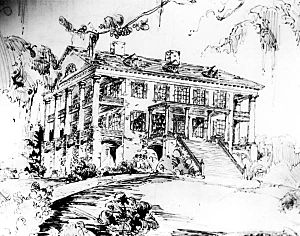History of slavery in Florida facts for kids
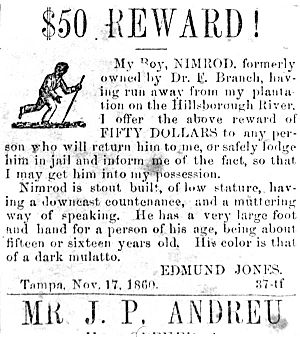
The history of slavery in Florida is a long and complex story. It began even before Europeans arrived, as some indigenous peoples practiced slavery. Florida was one of the first places in what is now the United States to have African slaves, starting in 1526. It also saw the first freeing of escaped slaves in 1687 and the first settlement of free Black people in 1735.
During Spanish rule, not many enslaved Africans were brought to Florida. However, starting in 1687, slaves who escaped from English colonies to the north could gain their freedom in Florida if they became Catholic. When Florida later came under British and then American control, slavery became much more common.
Slavery in Florida officially ended with the Thirteenth Amendment in December 1865. However, it unofficially stopped in the spring of 1865. This happened as news spread that the Civil War was over and the Confederacy had fallen. Many newly freed African Americans left their plantations to find family members they had been separated from. Even after slavery ended, some unfair practices continued, like sharecropping and convict leasing. Today, some migrant farm workers still face very difficult conditions.
Contents
Slavery Under Spanish Rule
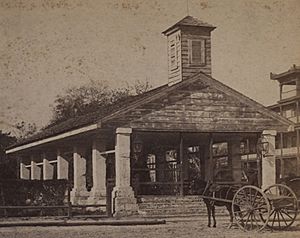
The first enslaved African in Florida was Estevanico, who arrived in 1528. More African slaves came with Hernando de Soto in 1539. When the Spanish founded San Agustín in 1565, some Native Americans were already enslaved there.
The Spanish did not bring many slaves to Florida. There were no large mines or plantations needing many workers. Florida had only three main Spanish outposts: St. Augustine, St. Marks, and Pensacola.
Under Spanish rule, enslaved people in Florida had more rights than in English colonies. They could marry, own property, and even buy their own freedom. Free Black people, if they were Catholic, faced less legal unfairness. Children were not born into slavery automatically. Also, mixed-race marriages were allowed, and their children could inherit property. These ideas were very different from what was common in the United States at the time.
Freedom for Escaped Slaves
In October 1687, eleven enslaved Africans escaped from Carolina to Florida. The Spanish authorities freed them. In 1693, King Charles II of Spain made a rule. It said that all slaves escaping from English North America would be freed if they became Catholic. This rule was similar to earlier Spanish decrees for slaves escaping from other European colonies.
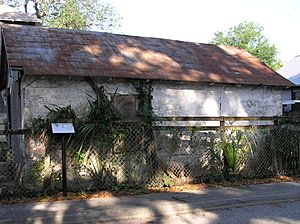
From 1688, Spanish Florida became a safe place for many fugitive slaves escaping from the British colonies. Once they reached Florida, the Spanish freed them if they converted to Catholicism. Men also had to serve in the military.
Many of these freed slaves settled in Gracia Real de Santa Teresa de Mose, near St. Augustine. This was the first settlement of free Black people in North America. A fort was built there in 1738 to protect St. Augustine. The freed slaves knew the border areas well. They led military raids against the Carolinas and Georgia, often under their own Black officers.
Other former slaves found safety among the Creek and Seminole Native Americans. These groups had settled in Florida after being invited by the Spanish government. In 1771, Governor John Moultrie noted that "negroes" often ran away to Indian towns. When British officials asked the Native Americans to return the slaves, they refused. They said they had only given food to hungry people.
Florida Becomes American
After the American Revolution, more slaves from Georgia and South Carolina escaped to Florida. The U.S. Army began to enter Spanish territory more often. This included the 1817–1818 campaign by Andrew Jackson, known as the First Seminole War. After this, the United States largely controlled East Florida.
Spain decided to give Florida to the United States. This happened through the Adams–Onís Treaty of 1819, which became official in 1821. Spain had found Florida expensive to maintain. It did not produce much that Spain wanted.
Florida Under American Rule
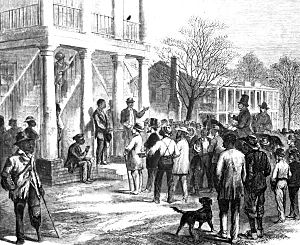
Florida became an organized territory of the United States on February 22, 1821. Slavery continued to be allowed.
Free Black People Unwanted
Many free Black people and Black Seminoles who lived near St. Augustine fled to Havana, Cuba. They wanted to avoid being under U.S. control. Some Seminole also moved further south. Hundreds of Black Seminoles and escaped slaves went from Cape Florida to The Bahamas. They settled on Andros Island, founding Nicholls Town.
In 1827, free Black people were not allowed to enter Florida. In 1828, those already there were not allowed to gather in public. In antebellum Florida, many believed that free Black people were a threat to the system of slavery. Laws became stricter. Free Black people were seen as "an evil" because they showed slaves that freedom was possible.
By 1847, all free Black people had to have a white person as a legal guardian. In 1855, a law stopped free Black people from entering the state. In 1861, another law required all free Black people to register with a judge. They had to give their name, age, color, sex, and job, and pay a fee. If they did not register, they could be claimed as a slave by any white person.
Plantation Growth and Secession
American settlers started building cotton plantations in northern Florida. These plantations needed many workers, so owners bought more slaves. On March 3, 1845, Florida became a slave state.
Almost half of Florida's population were enslaved African Americans. They worked on large cotton and sugar plantations in the north-central part of the state. By 1860, Florida had 140,424 people. About 44% of them were enslaved, and fewer than 1,000 were free people of color. The labor of enslaved people produced 85% of the state's cotton. In Leon County, which was a center for plantations, enslaved people made up 73% of the population.
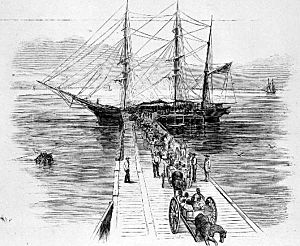
In January 1861, Florida's leaders voted to leave the United States. They declared Florida "a sovereign and independent nation." The main reason for this decision was to protect slavery.
During the American Civil War, Confederate leaders used enslaved people to transport supplies and work in salt factories and fisheries. Many enslaved people working in coastal areas escaped to Union-controlled areas. Starting in 1862, Union military actions encouraged more slaves to flee their owners. Some worked on Union ships. After the Emancipation Proclamation in 1863, more than a thousand joined the United States Colored Troops as soldiers and sailors.
Escaped and freed slaves gave valuable information to Union commanders about Confederate troop movements. They also shared news of Union victories with those still enslaved. Plantation owners' fears of slave uprisings grew as the war continued.
In May 1865, the U.S. government took control again, and slavery was officially ended in Florida.


